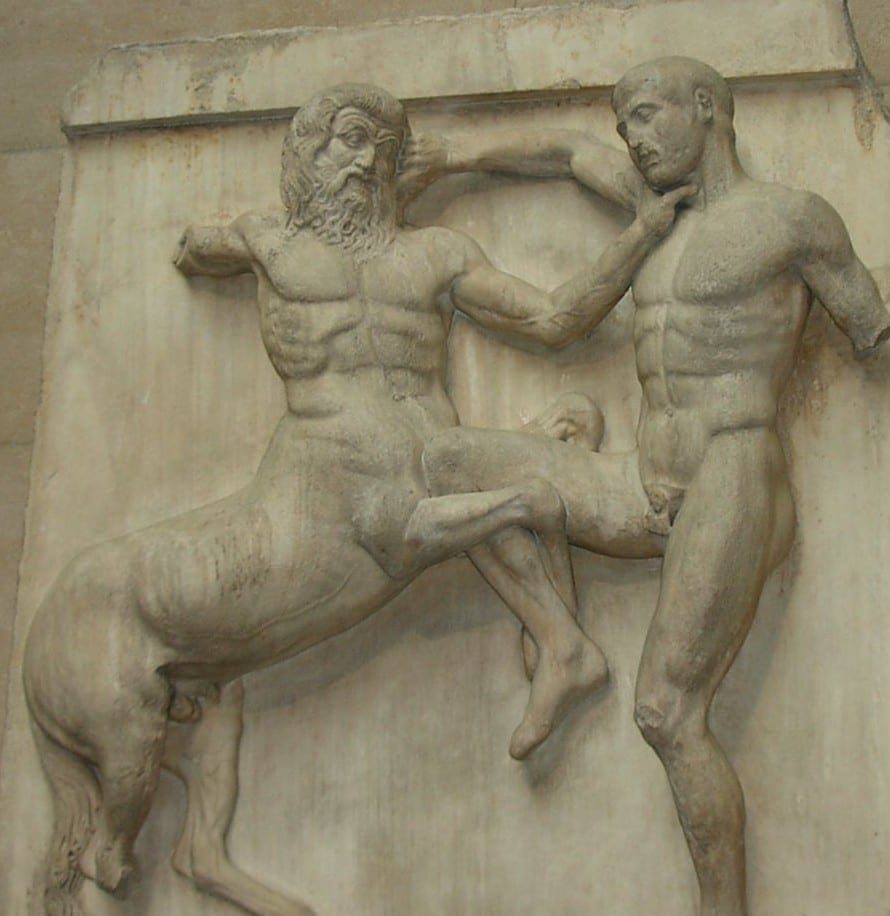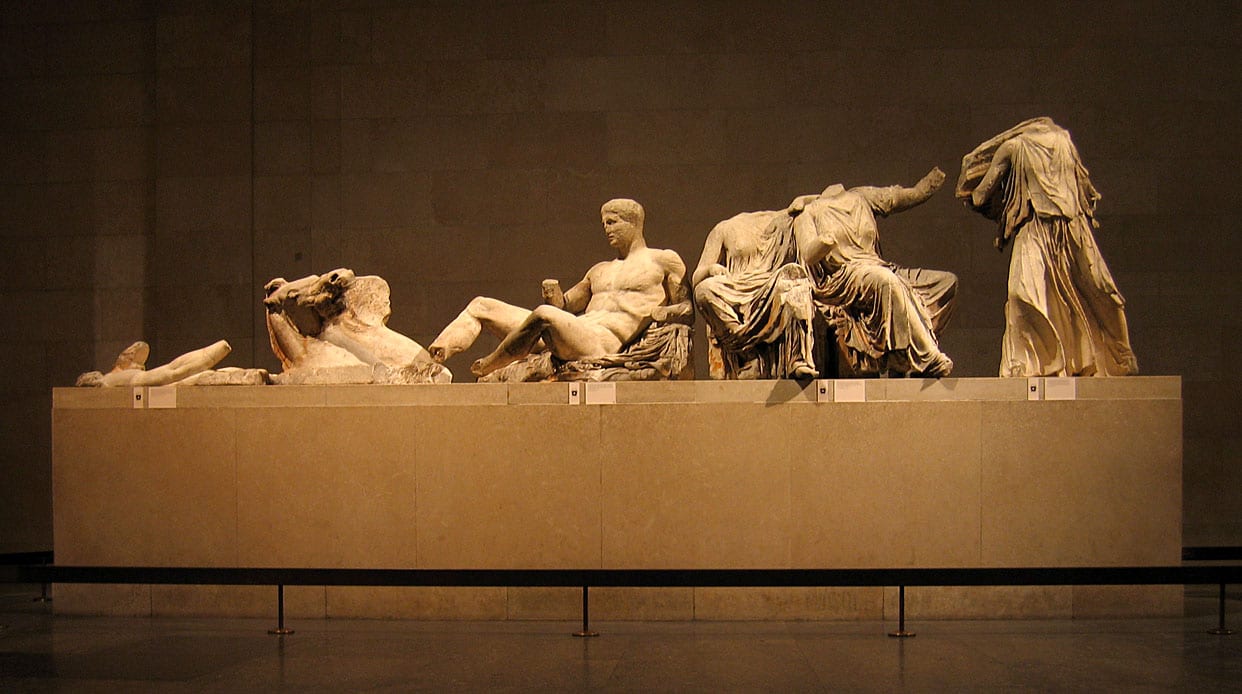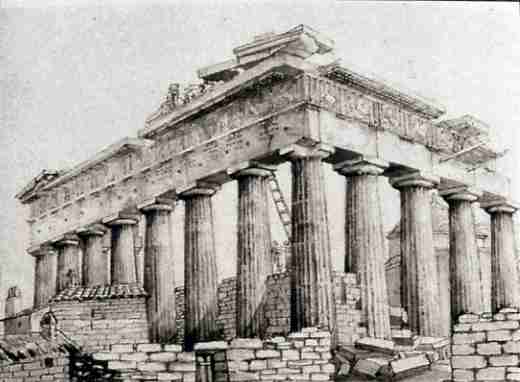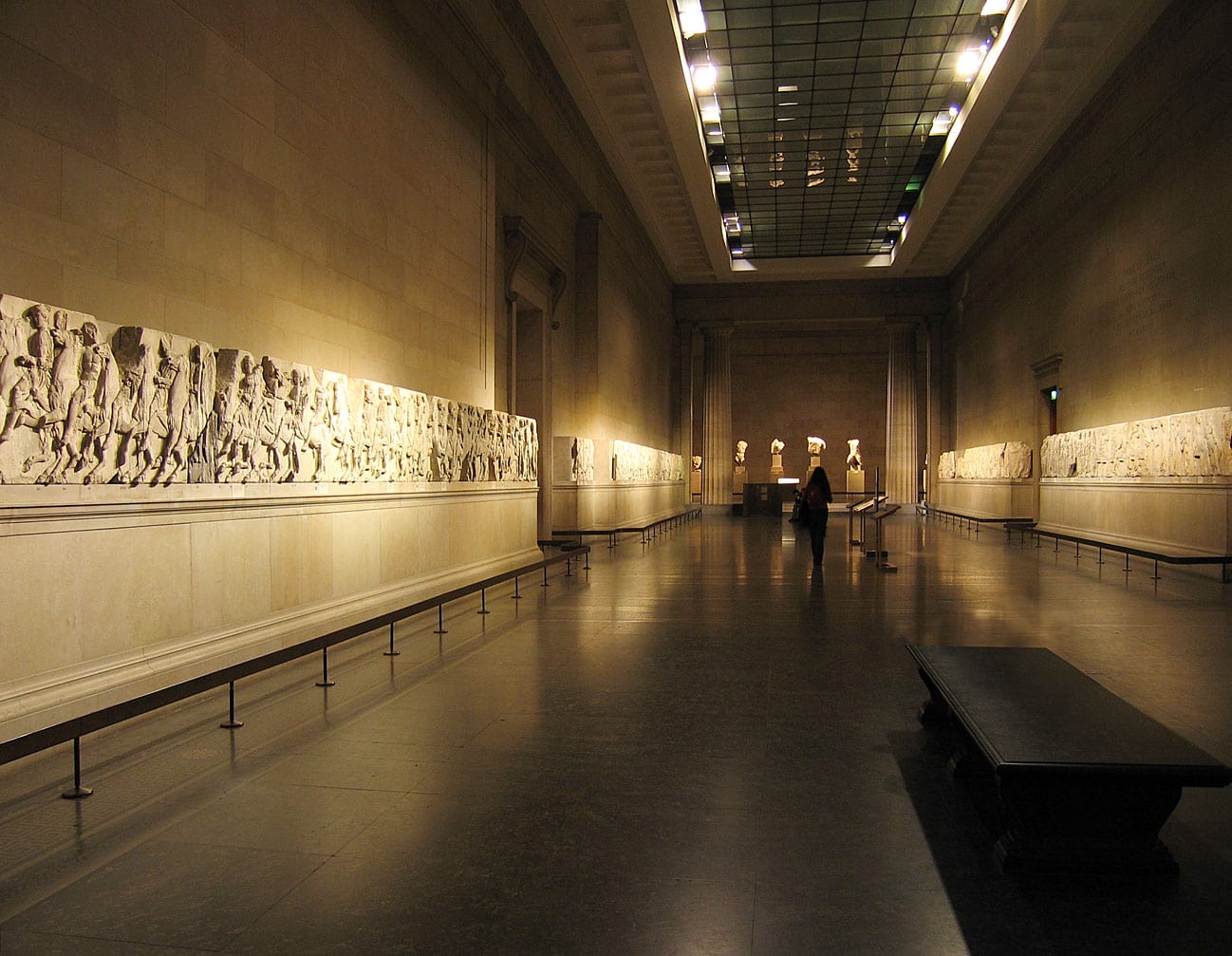Table of Contents
“On Seeing the Elgin Marbles” Past, Present, and Future
 |
| One of the Elgin Marbles (British Museum) |
What are the Elgin Marbles?
The Elgin Marbles, also known as the Parthenon Marbles, were Athenian sculptures taken from the Parthenon and brought to England in 1806 by Thomas Bruce, Lord Elgin. Most of these sculptures are still found in the British Museum. As a result, the British and Greek governments have been arguing over true ownership of these classic pieces of Greek artwork. The British claim that Lord Elgin purchased these marbles legally and should remain where they are while Greece holds that they were indeed stolen and should be brought back home. Controversy over these beautiful, classic sculptures has lasted for 200 years.
Background to the Poem
Like millions of other people, John Keats found himself along with his friend Haydon marveling at the foot of these ancient sculptures in 1817, a mere 11 years after they were shipped to England from Athens, Greece. From the observer’s perspective, Keats experienced an overwhelming sense of his own mortality and appreciation for the classical artwork. Soon after his visit to the British Museum, John Keats wrote the poem “On Seeing the Elgin Marbles” to share his experiences.
“On Seeing the Elgin Marbles”
– John Keats
My spirit is too weak – mortality
Weighs heavily on me like unwilling sleep,
And each imagined pinnacle and steep
Of godlike hardship tells me I must die
Like a sick eagle looking at the sky.
Yet ’tis a gentle luxury to weep
That I have not the cloudy winds to keep
Fresh for the opening of the morning’s eye.
Such dim-conceived glories of the brain
Bring round the heart an undescribable feud;
So do these wonders a most dizzy pain,
That mingles Grecian grandeur with the rude
Wasting of old time – with a billowy main –
A sun – a shadow of a magnitude.
Analysis of the Poem
Very similar to “On First looking into Chapman’s Homer” and “Ode on a Grecian Urn,” John Keats is inspired by marble statues and friezes taken from the Parthenon in Athens by Thomas Bruce, also known as Lord Elgin, and put in the British Museum. Upon seeing these ancient pieces of artwork, Keats reflects inward, judging upon his own mortality in the first lines of the poem: “My spirit is too weak – mortality / Weighs heavily on me like unwilling sleep” (ln 1-2). These marbles hold in them an immortal tale of gods that has been passed down from generation to generation from ancient times. Keats is coming to understand that far after his life is done, these stories will live on: “And each imagined pinnacle and steep / Of godlike hardship tells me I must die / Like a sick eagle looking at the sky.” (ln 3-5). Again, Keats is reiterating his morality by comparing himself to a sick eagle in line 5. An eagle is a well known symbol of freedom and a sick eagle which cannot fly therefore does not have the ability to be free. John Keats emphasizes the fact that his humanity constricts his freedom unlike the gods who are not bound by mortality. The only comfort or “luxury”, as Keats puts it in line 6, is the fact that he can feel sorrow for his situation.
Another interesting observation to make is that these beautiful marbles are mortal themselves. Although these statues of “Grecian grandeur” (ln 12) remind Keats of his own mortality, the reader realizes that these statues are fragile and subject to destruction similar to the human being. Much like other Romantic poets have pointed out, physical, earthly objects only give us glimpses at actual beauty and power. This unobtainable beauty and power will forever live on, much like the gods themselves depicted on the Elgin Marbles, when Keats and even the marbles have long since disappeared.
Ironically enough, the controversy over the Elgin Marbles has continued well passed the death of John Keats in 1821. Similar to the stories depicted on them, the marbles’ own story will forever be immortal.
The Past: A History of the Elgin Marbles
The Parthenon: Temple of Athena
 |
| Parthenon Reconstructed (Joseph Küschner) |
The Parthenon was built between 447 and 438 BC in honor of the Greek goddess of wisdom Athena. The building and sculptures were made of marble from Mount Pendeli and was crafted by the Greek architects Ictinos and Callicrates. The Parthenon had what are known as pediments, or the triangle sections of the building, which depicted stories of the life of Athena. The east pediment depicted the birth of Athena, as she sprung from Zeus’s head. On the other hand, the west pediment told the story of the competition between Athena and Poseiden, Greek god of the sea, over who would be patron over the city. Each side also portrayed different heroic stories of battles: the battle between the gods of Olympus and the giants (known as Gigantomachy) on the east, Greeks battling the Amazons on the west, the fall of Troy on the north, and the battles between men and the centaurs (known as Centauromachy) on the south. Ninety-one metopes or marble panels represented these battles. Many of these metopes were lost, destroyed, or badly preserved.
 |
| Marbles from the East Pediment (Andrew Dunn) |
Amazingly, the Parthenon remained, on a whole, intact even through the Roman conquests, though many of its treasures including the massive statue of Athena herself were looted or defaced. It went through many changes, becoming the Roman Catholic Church of Notre Dame shortly after 1204 and a mosque during the Turkish occupation in 1456. However, in September of 1687, the Venetians laid siege to the city and the Parthenon was struck by a cannon blast. As a result, the building’s roof exploded, columns were taken down, and many of the precious statues were laid to waste. To add insult to injury, the Venetian general Morosini made a failed attempt to take the surviving sculptures from the west pediment back to Venice. The cables hoisting the sculptures down broke, causing them to fall to the ground and shatter into pieces. For years, the remaining sculptures would be defaced by tourists who would leave carved messages in the walls or the noses from the statues as souvenirs.
Lord Elgin: Tragic Hero or Calculating Thief?
Thomas Bruce was the Seventh Earl of Elgin. Born on July 20, 1766, he was a British nobleman who was well educated and at age 29 had the privilege in becoming a lieutenant colonel in the British military. By 1798, Lord Elgin found himself in quite a predicament: broke, unmarried, and in ill health. Desperate to turn his luck around, Lord Elgin asked to be sent to Constantinople, a part of the Ottoman Empire at the time, as an ambassador for the British government, which he got. Another positive change to his life was his marriage to the wealthy heiress, Mary Nisbet of Earlton, soon after in 1799. Excited by the change, Lord Elgin set off in the very same year to Constantinople with his new bride. His main concern was to protect British trade, but he also wanted to experience the classical architecture of Greece as well as a new climate, hopefully aiding his health. He brought on his journey artists to sketch and recreate the beautiful Grecian artwork. What he didn’t expect what controversy he would begin after his travels.
As the Turks waged war against the French, the British were seen as friends and allies. For several years, Lord Elgin served as ambassador in Constantinople, watching over British interest in trade as it flourished and opened into the Black Sea. In time, the climate took its toll on Lord Elgin’s body. He contracted syphilis, asthma, and rheumatism as well as a severe flesh eating disease, which left his face disfigured and made his nose fall off. This tragic turn of events made him the butt of cruel jokes in British society as well as unattractive to both his friends and his family, especially his young wife. However, he continued his mission as British ambassador up until 1803.
In 1801, soon after the French’s surrender in Cairo, the Ottoman government granted Lord Elgin permission through a firman, or a royal mandate, to enter the Parthenon and “take away anything of interest.” This decree was delivered to the Viavode of Athens. Most excited by the events, Lord Elgin hired Greek laborers to help collect pieces of shattered statues. However, this seemed to be not enough. Soon, Lord Elgin received permission from the Viavode to extract the Grecian metopes as well as other artwork and bring it to the British Consulate so they could be drawn. No one really knows how this came to be. Some say that the Viavode was eager to please the Ottoman government’s ally, the British. Others say that Lord Elgin bribed him. Nonetheless, the history of the Elgin Marbles began at this moment of time. Lord Elgin made the decision to load these precious statues onto boats and ship them back to England. His reasoning was to protect their history as well as beautify and encourage the arts in his homeland. Is this sound reasoning or just an excuse to rob Greece of their ancient architecture?
 |
| Taking a part the Parthenon (Giovanni Battista Lusieri) |
Bad luck soon revisited Lord Elgin as he made his journey back to England. First, Lord Elgin could not get a boat large enough to take all the marbles at once. So, he opted for several smaller boats. His boat, the HMS Mentor, had seventeen cases on board filled with the finest sections of the Parthenon and sank during a storm in Kythera. It would take two years to retrieve all the treasures from the bottom. To add to this, the French and the Turks became allies again and France declared war on England in May of 1803. Lord Elgin was in France during this time and was arrested because he was a British man of military age. He was held as a prisoner of war for the next three years until he was released back to England in 1806. There, he found his wife with another man and his precious marbles in ports all a crossed the coastline. Following his scandalous divorce, the British government refused to pay Lord Elgin back for his troubles of bringing the marbles to England and other expenses. Since he was out of money, the only place the marbles could go was in a shed in his backyard. They were finally bought by England in 1816 for 35,000 pounds and were placed in the British Museum. Lord Elgin passed away in 1841, much in debt and also very much misunderstood.
The Struggle Begins
Ever since the Parthenon Marbles were extracted from their original home and shipped overseas to England’s shores, there has been controversy on who has rightful ownership: Greece or England? Another question that coincides with this one is whether Lord Elgin is truly a hero or a thief. It is hard to say whether or not Lord Elgin’s means of obtaining the beautiful artwork was in fact legal. The actual firman given to Lord Elgin by the Ottoman Empire has long vanished and only a translated copy still exists. The contents of this copy are highly disputed and the lord’s intentions of taking the marbles are still unclear. Still, even to this day, the marbles along with Lord Elgin are the center of controversy.
The Present: Where are they now?
The British Museum is not the only museum to house the Parthenon Marbles. In fact, nine museums in eight different countries have pieces of the Parthenon, including the Louvre, one of the most famous museums found in Paris, France. Here’s a list of the places you may visit to see these marvels:
- The Acropolis Museum, Athens: Fourteen blocks of the West Frieze are found here after they were taken from the Parthenon to prevent more damage from the weather in 1993.
- The British Museum, London: The Elgin Marbles as well as casts of the West Frieze are housed here.
- Musée du Louvre, Paris
- Vatican Museums
- National Museum, Copenhagen
- Kunsthistorisches Museum, Vienna
- University Museum, Würzburg
- Museo Salinas, Palermo
- Glyptothek, Munich
(List found on The British Museum website)
 |
| The Elgin Marbles in the British Museum (Andrew Dunn) |
The Future: Homeward Bound?
Over the last 200 years, the Greek government has argued with the British government, demanding that the Parthenon Marbles be given back, even if they are on permanent “loan” to the New Acropolis Museum located in Athens. However, the British Museum has issued a statement on April 21, 2007 explaining that they are in a position where they cannot lend out the pieces for two reasons. First, they have become an integral part of the museum itself. Along with this, the Greek government refuses to recognize Britain’s ownership of the marbles, which is a crucial part of lending any piece of artwork to any museum. The Trustees of the British Museum simply believe that the Elgin Marbles as well as the other sculptures found in various museums throughout the world benefit the general public since they do not need to travel to Greece to experience its grandeur. The remaining question is such: will the marbles ever make it back to their original home, Greece? Only time will tell.
Works Cited:
Andrew Dunn, http://www.andrewdunnphoto.com/, found: https://sites.udel.edu/britlitwiki/files//2018/06/ImageElgin_Marbles_British_Museum.jpg and https://sites.udel.edu/britlitwiki/files//2018/06/ImageElgin_Marbles_east_pediment.jpg
The British Museum, “The Parthenon Sculptures” www.britishmuseum.org/the_museum/news_and_debate/debate/parthenon_sculptures.aspx
British Museum, https://sites.udel.edu/britlitwiki/files//2018/06/ImageAc_marbles.jpg
Giovanni Battista Lusieri, http://commons.wikimedia.org/wiki/Image:Lusieri_at_work_at-Parthenon.jpg
Joseph Küschner, https://sites.udel.edu/britlitwiki/files//2018/06/ImageParthenonRekonstruktion.jpg
Matt Barrett, “The Parthenon (or Elgin) Marbles” http://www.athensguide.com/elginmarbles/index.html
Mary Beard. “Lord Elgin – Saviour or Vandal?” http://www.bbc.co.uk/history/ancient/greeks/parthenon_debate_01.shtml
Contributor:
Samantha Zulkowski
“Ode on a Grecian Urn” Revisited
What Is A Grecian Urn?
 |
| Photograph by Richard Oldfield |
The urns of early Ancient Greece were for everyday use; to carry water, or hold wine. Some urns were even given as trophies to the winners of a sporting event. As society became more advanced in their knowledge, the art of the urn began to prevail. During the Protogeometric and Geometric ages, the Grecians decorated the urns with shapes and the urn remained its natural color. Later in the era though, the artists were able decorate with actual beings and use colors. The hues that could be used were black, red and yellow but the colors were limited by the firing.(Art, Pottery)¹ The scenes that were painted on the urn were of greek gods and myths, or of battle or hunting scenarios. The knowledge of these urns is important to the realization of the reality in John Keat’s poem Ode to the Grecian Urn. As he decribes how the scene changes on the urn in his poem, we are able to create a visualization of the urn in the poem.
Analysis of Poem
By using words and phrases that invoke the image of a grecian urn, the reader is able to connect with the speaker of the poem and see what he is seeing. The poem begins by describing the urn as a Sylvan historian, meaning that the urn is telling the history of forests, which in fact would hold true. Very often Grecian urns would depict tales that were set in forests. The first stanza also stresses the importance of the urn’s silence; informing the reader that what is being described is merely an object. Keat’s uses phrases like “bride of unravish’d quietness”, and ” foster child of silence” (Line 1, 2). It is the silence of the urn that makes it viable for the speaker to question the tale that is depicted.
Not only does the speaker question the tale, but he admires the ability of the urn to immortalize beauty and truth. Keats writes, “do not grieve;/She cannot fade, though thou hast not thy bliss,/For ever wilt thou love, and she be fair!” (Line 18-20) So even though the man is in constant persuit of this beautiful woman on the urn, he will never fall out of love with her and she will be eternally beautiful. Time has no impact of the the urn’s tale creating an immortal story. Keats continues to admire the timelessness of the story by noting the eternal spring of the setting proclaiming, “happy, happy boughs! that cannot shed/Your leaves, nor ever bid the spring adieu” (Line 21-22). The pictures on the urn shall never change therefore it will always be springtime on the urn. Keat’s continues, “And, happy melodist, unwearied,/For ever piping songs for ever new;/More happy love! more happy, happy love!/For ever warm and still to be enjoy’d,/For ever panting, and for ever young” (Line 23-27). In lines 23-24, Keats is speaking about the melodist, on the urn, who will forever make new and happy songs on his pipe; songs which will never grow old due to the urn and it being “frozen” in time. Following these lines, Keats is speaking of the young lovers whose love will never grow cold and unhappy. The man will be “For ever panting” because, on the urn, he will always be chasing his lover, and the two will never grow old. These lovers will never experience “All breathing human passion far above,/That leaves a heart high-sorrowful and cloy’d,/A burning forehead, and a parching tongue (28-30). Love, in life, does not always last forever. It sometimes grows tired and old, but for these two young lovers, frozen in time, that will never happen. They will never feel what a “heart high-sorrowful and cloy’d” feelings like.
The last two stanzas of the poem are significant with respect to Art. In section IV, the speaker relates to the importance of one’s imagination and how art helps one bring out the emotional and more significant aspects of life. There is a certain amount of trust that is discovered when Keats mentions three different towns, in hopes that a permanent discovery will be found. When Keats states, “will silent be!” he is examining that the urn is frozen in time and will be silent and contained with all of the emotions and feelings kept within.
Background on the Romantics:
The literary movement of the early 19th century was known as the Romantic time period. Writers of this time emphasized the importance of using emotions and self-expression to gain an insight to truth. Unlike previous literary periods, the idea of following and studying the classics was rejected. For example, writers and poets from the Augustan time period strongly believed that great literature followed strict guidelines, such as following the classics, and followed a very different criteria regarding literature. The Romantics’ primary focus however, was encompassing truth by means of exploring and expressing emotions on a level that could not be reached by recreating ideologies of the past.
The idea of becoming closer to Nature and the emphasis on the use of ordinary people and language are also important characteristics of the Romantics. John Keats, along with other famous writers such as William Wordsworth and Samuel Taylor Coleridge examine the reality of Nature, and use subjects that are appeal and relate to the ordinary person. The creation of a new type of language was even attempted by Wordsworth in order to portray the significance of the ordinary man. It is through the imaginative and creative characteristics of the Romantic time period that writers, such as Wordsworth, Coleridge and Keats, were able to construct such profound pieces of literature.
 |
| John Keats’ Signature |
“Ode On A Grecian Urn”
by John Keats
 |
| Sketch of John Keats by Joseph Seven, 1816. |
Thou still unravish’d bride of quietness,
Thou foster-child of silence and slow time,
Sylvan historian, who canst thou express
A flowery tale more sweetly than our rhyme:
What leaf-fring’d legend haunt about thy shape
Of deities or mortals, or of both,
In Tempe or the dales of Arcady?
What men or gods are these? What maidens loth?
What mad pursuit? What struggle to escape?
What pipes and timbrels? What wild ecstasy?
Heard melodies are sweet, but those unheard
Are sweeter: therefore, ye soft pipes, play on;
Not to the sensual ear, but, more endear’d,
Pipe to the spirit ditties of no tone:
Fair youth, beneath the trees, thou canst not leave
Thy song, nor ever can those trees be bare;
Bold lover, never, never canst thou kiss,
Though winning near the goal – yet, do not grieve;
She cannot fade, though thou hast not thy bliss,
For ever wilt thou love, and she be fair!
Ah, happy, happy boughs! that cannot shed
Your leaves, nor ever bid the spring adieu;
And, happy melodist, unwearied,
For ever piping songs for ever new;
More happy love! more happy, happy love!
For ever warm and still to be enjoy’d,
For ever panting, and for ever young;
All breathing human passion far above,
That leaves a heart high-sorrowful and cloy’d,
A burning forehead, and a parching tongue.
Who are these coming to the sacrifice?
To what green altar, O mysterious priest,
Lead’st thou that heifer lowing at the skies,
And all her silken flanks with garlands drest?
What little town by river or sea shore,
Or mountain-built with peaceful citadel,
Is emptied of this folk, this pious morn?
And, little town, thy streets for evermore
Will silent be; and not a soul to tell
Why thou art desolate, can e’er return.
O Attic shape! Fair attitude! with brede
Of marble men and maidens overwrought,
With forest branches and the trodden weed;
Thou, silent form, dost tease us out of thought
As doth eternity: Cold Pastoral!
When old age shall this generation waste,
Thou shalt remain, in midst of other woe
Than ours, a friend to man, to whom thou say’st,
“Beauty is truth, truth beauty,” – that is all
Ye know on earth, and all ye need to know.”
 |
| Black-figure Neck Amphora. Athens, 2nd quarter, 6th century BC |
From the Duke Classical Collection
| Other Places to Find Grecian Urns: The 1997 full length animated feature film produced by the Walt Disney Company, Hercules, featured Grecian urns as the transitions between gaps in time. Every time the story progresses, the film returns to the urn which continues to tell the story of the god-like human by the paintings on its side. In the following clips, the narrators of the story, the muses, use the urn as their visual aid. each urn scene begins with a shot of the storyline etched on an urn and morphs into the animation of the film. The movie even uses the correct color schemes that would have been used on the ancient urns. Also notice the intricacy of the art work and the square shape of the images that are depicted. While it is merely an animation, the clips are a helpful visual aid when reading Keat’s Ode to a Grecian Urn because it is a modern take on the ancient art form. |
(First Video Edited by wbslnger2004 ; Second Video Edited by essexboi1993 ; Third Video Edited by essexboi1993 )
Works Cited:
1. “Art in Ancient Greece”. Pottery. http://en.wikipedia.org/wiki/Art_in_ancient_Greece#_note-0 .
essexboi1993: Youtube.com, http://www.youtube.com/watch?v=FaVMxugfJuk . Hercules. Walt Disney Company. 1997.
essexboi1993: Youtube.com, http://www.youtube.com/watch?v=UkFUlPTyCVM . Hercules. Walt Disney Company. 1997.
Wbslnger2004: Youtube.com, http://www.youtube.com/watch?v=WIcV2gKcMlc . Hercules. Walt Disney Company. 1997.
2. “myth.” Encyclopædia Britannica. 2007. Encyclopædia Britannica Online. 20 Nov. 2007 <httpEncyclopædia Britannica, Inc., 2007.
3. Keats, John. “Ode on a Grecian Urn.” The Longman Anthology: British Literature. Ed. David Damrosch & Kevin J.H. Dettmar. New York: Pearson Education, Inc. 2006. 905-906.
Contributors:
Rebecca Kane, Lauren Cuddeback, and Amanda Tomasetti
